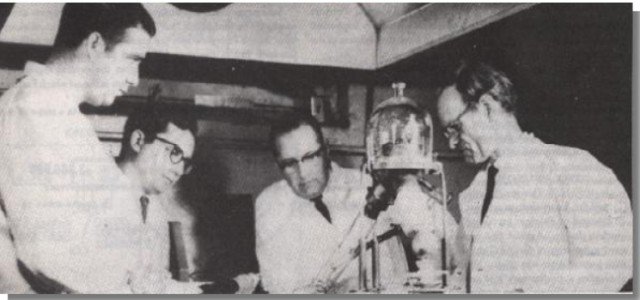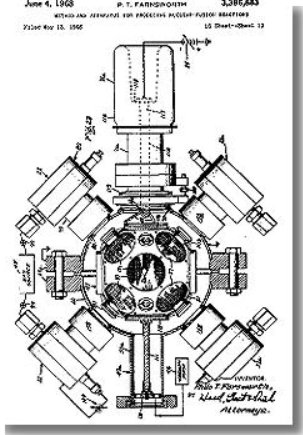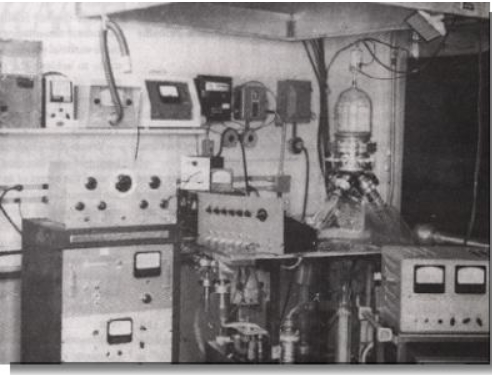
Hot fusion was the cold war quest. Besides the space race, fusion was the socio scientific dream. The loss of hope … the loss of myth … in this massive social project produced a brooding meditation among engineers who were devoted to its fulfillment. For Be better part of twenty years there were billions of dollars spent for fusion research … seemingly in vain….
The Farnsworth Fusor – The Most Notably Forgotten Episode in “Hot” Fusion History
by Gerry Vassilatos
Editor’s note: Survivalism among academicians is no less savage and ruthless than among…How ITT crushed fusion development and enslaved mankind to carbon. Jeff Smith, VT Science Editor
A recent excellent article by Lawrence Forsley recounted each major step in the history of “hot fusion” projects. The account depicts the arduous pursuit of hopeful and brilliant personnel chasing after a prize which never appeared. This chapter in technological history left most scientific researchers with a sense of silent despair. Exploration of this inward sense of loss was an emotional item which few actually and honestly addressed. Yet the projects rolled on.
Hot fusion was THE cold war quest. Besides the space race, FUSION was the socio scientific dream. The loss of hope … the loss of myth … in this massive social project produced a brooding meditation among engineers who were devoted to its fulfillment. For the better part of twenty years there were billions of dollars spent for fusion research … seemingly in vain.
Each lost social dream becomes social malaise. Wars develop when social myths are deferred. The synthetic manufacture of new and continual myths replaces the hope deferred. Governments and regulators sponsor such alternative myths continually. The gross funding of new fusion projects represents a means for maintaining public morale at a very subliminal level.
The prize elusive was replaced by countless journals, articles, and texts … as if so much paper would fulfill the absence of the Grail. This general sense of misdirection among most physicists was balanced by a furious return to the chalkboards and publishing homes. The dream deferred became mere talk and analysis. Theoreticians, at least, found continual employment.
Shelves of once optimistic theoretical works on fusion were suddenly flooded over with equally optimistic and authoritarian apologetics. These inflated works proclaimed the “way out” through newer magnetic containment systems.
While most project personnel simply dissociated themselves from the race for controlled fusion, others (foolishly) raised their broken swords higher and “challenged nature to achieve where anti others failed. This of course meant that grant monies were to be sought again … despite the generally accepted hopelessness of the quest Fusion researchers were trapped, like some modern Tantalus … in magnetic containment
MAGNETIC CONTAINMENT
The tragedy of each magnetic containment device lay chiefly in the theoretical promise which always failed. The hope deferred seemed to flood each separate project not long after a particular device was constructed. One usually knew after the very first trial what the end would be … and how soon it would come.
In methodic succession, and after several billion dollars were spent it became apparent that the magnetic containment systems would not succeed at all. Mercurial and elusive, certain designers attempted to “steal the secret” despite the natural odds: to fight with Nature and wrestle from her jealous hands the guarded gold. Not one imagined that perhaps their method was the wrong one … that Nature would not let go of her gold because the suitors were behaving like barbarians.
The need for the gigantic was also a feature of these projects. No units smaller than a gymnasium could meet the theoretical need. Somehow both the theoreticians and project designers believed the delusion that size and symmetry would “make the difference” in magnetic systems. Always the secret hope was held that “this one might do it.” Small laboratory devices produced unstable plasmas because they were small. Larger devices should produce more crushing power … like building an ever larger press to squeeze a lightning bolt.
Many project designers simply failed to promise a fusion achievement altogether from the outset … preferring to maintain the “safe grounds of plasma analysis.” The ancillary projects (instability analysis, arc analysis, plasma contamination, plasma diagnostics) made their appearance … a flood of “studies” … but no reactor. Grant money was poured into “plasma analytic methodologies” and almost dominated the scene where working fusion reactors should have stood.
P. Kapitza studied ball lightning phenomena with a remarkably opened mind when few academicians would not even dare touch the topic at all. S. Ulam also studied reports of the accidental formation of plasmoids among submarine generators and arc switching devices. Others studied the piezoelectric formation of plasmoids in rock fractures. Thorough research on Tesla Technology (and Tesla’s means for generating plasmoids at will) seemed to open doorways toward new possibilities.
M. Theroux developed a special Tesla transformer which actuary projected small aerial plasmoids … and could repeat the performance. The Air Force funded a much larger project toward this end (R Golka). Each was looking for the answer in a new realm. And this was the precise answer … to look elsewhere for that which intuition envisions.
Intuition craves confirmation however. Too few of these “new view” researchers were actually familiar with the archives of both natural and laboratory anomalies. No one remembers what has already been achieved in isolated laboratories. Very often a chance occurrence, however subtle, gives the new direction to the world. New hydrogen energy, you will remember, was observed by several qualified persons in diverse places. Had these records been forgotten, perhaps the new revolution might never have been forged.
Were the hot fusionists true and ardent students of the stored periodical treasure house they too would not have simply written more superficial papers on their views. They would have known what to do to achieve the prize itself, for the answer was there … in a group of patents some twenty five years old which should have been known by all of them collectively. Perhaps they would have found their way back to the forgotten mines … but then came Tokamak.
When the Tokamak rose in the east, it seemed to offer the brightest new morning of life for fusion research. Many stole away to steal the secret of its fire. But even the Tokamak failed to deliver the immediacy of its promised prize. So deeply resentful were many researchers after the postponement of immediate success that few would even believe that the goal could be reached at all.
It is not unreasonable (given the emotional infrastructure of fusion research) that science had become first melancholy and then sanguine in all its subsequent discussions of controlled nuclear fusion. The topic represents (to the crusaders) a major dragon left undefeated. Most would rather forget the dream and all knowledge of it.
Forgotten knowledge was the main problem. Even before magnetic containment was attempted, there was a simpler answer to the particle containment problem. In his closing paragraphs Dr. Forsley asks that we imagine the truths which were lost through out this period in venture technology.
An answer had been recorded into the scientific ledgers already which would have spared these valiant workers much time, money, and disappointment. Forgotten knowledge started all the researchers off in the wrong direction from the start.
FORGOTTEN KNOWLEDGE
Unexpected devices of great import emerge from very old patent registers and periodicals. These developments span two hundred years of astounding technological progress, and chronicle our epistemological progress as a civilization. The literary treasure house of this time period contains incredible discoveries which remain yet unrecognized, unevaluated, and forgotten.
Despite this fact, many academicians are overly confident that “old knowledge” has been thoroughly comprehended and admixed into contemporary theory and is, therefore, expendable. This view is inwardly believed to such a degree that old texts are methodically being gathered into “annex” warehouses. These treasures are then permitted to decay and are (gradually) eliminated.
This shockingly repugnant pride is the very opposite of scientific sensibility. This mindset is counterproductive and totally self destructive. Each new unexpected discovery comes as a sharp rebuke to those who remain unenlightened concerning the past. Old texts preserve forgotten thoughts … not disproven thoughts. Researchers have committed their often anomalous and disquieting observations and findings to the journals and texts. It is traditional practice that what cannot be now explained must be treasured, pondered, and comprehended for some future purpose. Discovery and anomaly are rare gifts which must be honored and preserved until understood.
The scientific historian methodically searches out catalogues of forgotten phenomena by thorough examination of old periodicals, texts, and patent files. The retrieval of old and forgotten observations, discoveries, scientific anecdotal records, and rare natural phenomena provide the intellectual dimension desperately needed by modern researchers who work in a vacuum of dogma. It is astounding to find the volumes of rare and anomalous phenomena lists and laboratory anecdotes made by credible and qualified Victorian researchers throughout older volumes of Nature Magazine and The Electrician (c.1890).
The retrieval of inventions, designs, and other applications reveal repeatable phenomena “in application” which demand re evaluation of tenaciously held theoretical models. The trained researcher identifies, distinguishes, and secures those particular forgotten discoveries which violate contemporarily held theoretical models. The aim of this research is new knowledge through reevaluation.
Eric Dollard is an electrical engineer who has done remarkably exhaustive historical research and experimental verifications of scientific claims made by Nikola Tesla a century before. It was through Mr. Dollard that we learned about a forgotten chapter in the art of controlled thermonuclear fusion like no other. In fact, those who read this article may be shocked to learn the real truth about one specific “hot fusion” project from 1962 until 1967.
The reality of anyone controlling fusion reactions … and reaching self sustaining reaction stage would sound bizarre to anyone familiar with the historical publications. Of all the venture projects chasing after the hot fusion Grail one group of researchers looked directly into Nature’s brilliant face and saw her sparkling eyes. Mr. Dollard’s research on unusual electron tubes led him into an exhaustive study of several vacuum tube designs patented by the father of electronic television: Dr. Philo T. Farnsworth. There he found the forgotten gem.
PHILO T. FARNSWORTH
Among the incredibly prolific patents of Dr. Farnsworth are two working designs for achieving practical nuclear (“hot”) fusion. Dr. Farnsworth is the original designer of true electronic television. He had to develop the entire system of electronic television with all its parts. Image dissectors, pulse transmitters, synchronizing oscillators, synchronous scanning, image analyzers, receivers, and special cathode ray tubes … Farnsworth conceived, designed, and hand built each of them.
The technological demands of his complete television system required the development of very special electron tubes from start to finish. Each component demanded new tube designs and operational theories. In fact, examination of the Farnsworth patents reveals nothing but novel tube designs without contemporary equal.
Existing multi element tubes could neither match the stringent power demands or frequency requirements of television. Therefore Farnsworth developed numerous unusual tubes to make his television oscillators, receivers, and transmitters more efficient. No existing technology could match the performance characteristics of his UHF oscillators, electron multipliers, and cold cathode signal amplifier tubes when he patented them.
Farnsworth designed numerous high power UHF tubes. Notable among these designs were cold cathode devices (some of which employed soft radioactive materials), photomultipliers, multipactors, IR imaging tubes, image storage tubes, and image amplifiers. Each was a marvel of originality and inspiration. But the multipactor was a true wonder.
The multipactor design employs two opposed concave cathodes and a central series of cylindrical anodes. Noise surges generate and sustain powerful tunable oscillations within the multipactor when voltage is simply applied to the cathodes and anode. The multipactor utilizes photomultiplier effects to supply electrons. Multipactor performance borders on the anomalous, approaching “impossible” efficiency coefficients.. His success was followed closely by engineers from every military and industrial group. Full scale research addressed the multipactor efficiency “problem”. Reports from the time period may be easily secured for study and re evaluation.

The design feature of concave electrodes was a radical departure in the world of electron tube designs at the time. Most electrodes of the day were simple planar surfaces. The concaves permitted the re discovery of electron optics … a phenomenon originally witnessed by Sir William Crookes and forgotten. Students are directed to the Crookes tube with its concave cathodes.
 central feature during these tests was not the neutron count itself. What was sought in these tests lay in the control of the reaction under increasing power application. Farnsworth established and charted increasing neutron counts with increasing application of electrostatic power. It is suggested that the reader obtain and study copies of the Fusor (patent 3,386,883).
central feature during these tests was not the neutron count itself. What was sought in these tests lay in the control of the reaction under increasing power application. Farnsworth established and charted increasing neutron counts with increasing application of electrostatic power. It is suggested that the reader obtain and study copies of the Fusor (patent 3,386,883).
ITT gradually absorbed the entire project. All related patents were assigned to ITT as success was achieved in steady steps. While steady progress was being achieved at a modest cost (examine the photographs), lTT was being influenced by powerful professionally hired “opinion makers” to drop fusion research. Suddenly even Wall Street analysts were publishing their “concerns” for ITT and its absorption of the Farnsworth subsidiary. Farnsworth himself was made the focus of every corporate death-word. These outlandish accusations indelibly remain in newspapers from the time period.
One observes that the scientific community automatically digests potential possibilities whenever new unexpected discoveries manifest themselves. This again is that rigid kind of scientific dogmatism which holds forth the graven image of “the model” before the truth. The cultivation of new discovery is an unknown art in our day … except among a rare few.
What is “unexpected discovery”? Is it not the piercing reminder that theoretical models can never replace or truly confine natural reality? Yet there are those who have inwardly replaced reality with the model … and defend the model to the death. The bright light of any natural anomaly or unexpected discovery is hated precisely because it is feared. The model for many scientific personnel is secretly their “lifeline” … their mantra. These personalities are easy to identify. Unfortunately, in positions of power, they are formidable dissuaders of new technologies.
Why is unexpected discovery feared and hated by financial dynasties ? New technology spell. ruin for those whose status quo policy has eliminated them from the competitive race. Most very wealthy individuals are never passionate Makers. Neither are they true philanthropists. While removing the future on the one hand they make publicly acclaimed contributions on the other. The banal misuse of powerful positions wields control to stop progress.
A mystical belief of mine deals with the suppression of truth by corporate regulators … and the global consequences of such suppression. Discovery itself is a phenomenon. Discoveries are granted as tools of survival against future needs on behalf of our race.
Of discovery I may say that suppression and manipulation results in an unstoppable reaction … the frightening release of newer, simpler technologies in every corner of the world. This phenomenal dispersion so assaults would be controllers that no one regulator may ever seize, quench, or destroy the new technological species.
ATTENTION READERS
We See The World From All Sides and Want YOU To Be Fully InformedIn fact, intentional disinformation is a disgraceful scourge in media today. So to assuage any possible errant incorrect information posted herein, we strongly encourage you to seek corroboration from other non-VT sources before forming an educated opinion.
About VT - Policies & Disclosures - Comment Policy




Science became an industry on a hangover and cannot move very quickly. That’s where I see us now. We did go from horses to satellites in a very short time, and that question still has not even been addressed. Was this a natural phenomena as an evolving species, or something else ? Art, and the creative juices have been squelched by ever tightening order in academia and community. Comfort is the new religion, and it is not to be disturbed. This was the most comfortable pandemic any batch of crazy humans has ever been through. So, the hungover apes, seek fermented juice in convenient boxes and nice computers next to heated pools. Science has brought us comfort, and we are drunk on it.
Incentivize invention and release all patents after 5 years. Do art for half the day at school.
You shined on that one.
You can’t expect altruistic management of scientific breakthroughs from those who’ve gained control over all avenues of social power, and who also seek to reduce world population by 90%.
Comments are closed.